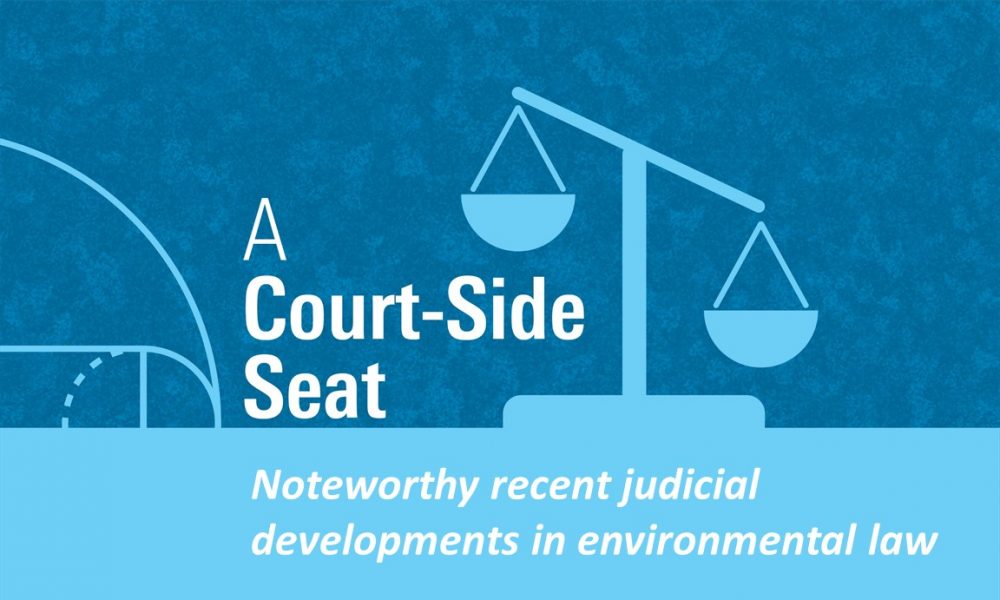Blog Gravel2Gavel Construction & Real Estate Law — October 28, 2024
But not this term. The Supreme Court’s current term began on October 7, 2024. The Court has chosen many cases for the new term. It promises to be just as interesting as the previous term in 2023, which produced several important rulings affecting administrative and regulatory law, including the Loper Bright Enterprises decision. Loper Bright overturned a landmark administrative law ruling by the Court in Chevron, USA, Inc., v. Natural Resources Defense Council, Inc., (467 U.S. 837) (1984).
The background to Loper Bright
In the year 1984, the Supreme Court decided Chevron USA, Inc., v. National Resource Defense Council. (See 467 U.S. 839 (1984).) The unanimous decision was written by Justice Stevens and reversed the then-D.C. Circuit Judge Ruth Bader Ginsburg’s ruling that set aside EPA’s Clean Air Act “bubble policy,” which was intended to provide regulatory relief from certain EPA permitting requirements.
Justice Stevens’ approach required the courts to defer to a reasonable and permissible agency interpretation of an ambiguous statutory provision that the agency was authorized to administer. He described a two-step process that federal agencies and reviewing court should use to assess an agency’s interpretation. (a) Has Congress specifically addressed the question at hand? If it has, the court’s investigation is over. The court will defer to an agency’s interpretation if the statute is unclear or silent. As a background to the Chevron decision, it is important to remember that, in the 1970s-80s, each presidential administration was deeply concerned about the fairness and the efficiency of federal departments. In 1978, the Supreme Court ruled Vermont Yankee Nuclear Power Corp. v. NRDC 435 US 519, which stated that a court could not impose rulesmaking procedures on a government agency. In the past, the D.C. The D.C. Circuit has been deeply involved in all kinds of routine federal agency proceedings such as the FCC review of changes to radio station program formats. (See FCC V. WGN Listeners Guild 450 US 582, 1981). This practice seems to be over. Relentless, Inc., v. Department of Commerce, a decision from the First Circuit, both addressed the question of what to do with Chevron during 2023. In both cases, the petitioners challenged a rule issued by the National Marine Fisheries Service (an agency of the Department of Commerce) that required certain commercial fishing vessels to pay for and carry a third-party witness. The petitioners argued that the Magnuson-Stevens Act did not authorize the promulgation of this rule. However, the D.C. Circuit and First Circuit used the Chevron framework in ruling in favor of government. The Supreme Court granted certiorari in both cases to address whether Chevron should be overruled or clarified.
Chief Justice Roberts’ opinion for the majority held that the decision in Chevron was flawed because it ignored the Constitution’s mandate that the judiciary must decide all questions of law, which is one of the basic provisions of the Administrative Procedure Act, Section 706, which “delineates the basic contours of judicial review of agency action.” Also, Chevron’s justifying presumption that Congress implicitly delegated this authority to the federal agencies, is dismissed as a “fiction.” The Court also notes that it had not relied on Chevron as a basis for any ruling on an agency interpretation since 2016. The Court also addressed the argument that stare decisivis requires it to continue to adhere to Chevron, despite its flaws. It stated that Chevron has become unworkable, unpredictable, and already laden with many exceptions and restrictions. The Court suggests that the 1944 case, which established “Skidmore Respect” for the use agency experience, may survive the demise Chevron deference. (See Skidmore v. Swift & Company 323 US 134, 1944). The Court believes that thousands of cases that were decided under Chevron’s auspices will not be disturbed. They will be entitled to a “statutory stare decisis.” Some experts have concluded that over 18,000 cases cited Chevron between 1984 and now. The Court granted certiorari to several pending cases and vacated the judgments. It then remanded these cases back to the appropriate federal appeals court for further proceedings based on the Loper Bright decision. It is too early to tell whether Loper Bright will have the impact that many observers predicted. However, it is far too soon to say whether Loper Bright will have the impact many observers have predicted.
The Court Wasn’t Finished
Within the space of a few days, the Court also issued significant rulings that: (a) interpreted and eased the standard six-year federal statutes of limitations governing appeals of final agency rules under the APA in Corner Post, Inc. v. Board of Governors of the Federal Reserve System; (b) confirmed the right to a jury trial under the Seventh Amendment in many civil administrative enforcement actions in SEC v. Jarkesy; (c) and provided injunctive relief in a complex EPA Clean Air Act proceeding in Ohio v. EPA.
In the Ohio case, the Court, in a 5-to-4 ruling, stayed EPA’s “good neighbor” rule which affects many states that may not be able to timely comply with a complex EPA Ozone new air quality standard while the D.C. The Court was not finished
In the Ohio case, the Court, in a 5-to-4 ruling, stayed EPA’s “good neighbor” rule which affects many states that may not be able to comply with a complex EPA Ozone new air quality standard while the D.C. This relief was not replicated in the New Term. The EPA’s new measures to control mercury emissions and methane emission controls were not stayed. The Court also issued significant rulings in other areas of the law in the 2023 Term, which we note below. However, it is important to note, remember the Court also issued significant rulings in other areas of the law in the 2023 Term, which we note below.
CONSTITUTIONAL RULINGS
National Rifle Association v. Vullo (decided May 30, 2024)
Here the Court held that the political pressures allegedly exerted by New York State’s Superintendent of Financial Services over the insurance entities it regulates in order to deny the NRA the ability to obtain “affinity” insurance from its members violated the First Amendment by coercing regulatory entities to transact their business relationship with NRA because of its new gun control. According to the Court, this was a clear case of “viewpoint discrimination.”
Consumer Financial Protection Bureau v. Community Financial Services (decided May 16, 2024)
The Court held that Congress’ enaction of a unique funding mechanism was consistent with the requirements of the Constitution. In a decision authored by Justice Thomas, the Court held that the unique “funding mechanisms” of this new federal agency comply with Constitution. According to the Court, the fact that the agency draws its annual funding directly from the Federal Reserve Branch and not through any individual annual appropriations bill does not violate the Appropriations Clause because a source of public funding is specified.
City of Grants Pass v. Johnson (decided June 28, 2024)
Reversing the Ninth Circuit, the Court holds that the City of Grants Pass, Ore., was well within its rights to enact local laws to restrict the growth of homeless encampments on public land. The Eighth Amendment to the Constitution simply does not apply to the enactment of such laws because they are not “cruel and unusual punishment.”
ADMINISTRATIVE LAW
Garland v. Cargill (decided June 14, 2024)
The Supreme Court held that attaching a “bump stock” to a rifle semi-automatic does not convert the rifle into a “machine gun” (whose possession is prohibited by federal law). The ATF’s newly promulgated rules interpreting the law to extend to buying such materials and explosions was not based on a correct ruling of the agency’s statutory authority.
Fischer v. United States (decided June 28, 2024)
This case concerned the Enron-inspired Sarbanes-Oxley Act. The government used a section of the Sarbanes-Oxley Act relating obstruction of Congressional Proceedings to prosecute defendants who took part in the demonstrations and riots that occurred at the Capitol on January 6, 2021. The Court held that the law does not apply to such incidents.
FDA v. Alliance for Hippocratic Medicine (decided June 13, 2024)
This is a “standing case.” Reversing the Fifth Circuit, the Supreme Court ruled that the plaintiff doctors contesting the FDA’s approval of the drug mifepristone lacked standing to challenge this action. The evidence submitted by the plaintiffs was often too speculative to demonstrate real and substantial harm to them because of this FDA action.
SOCIAL MEDIA CASES
The Court is approaching these unique cases very carefully.
Lindke v. Freed (decided March 15, 2024)
Here, a state legislator blocked one of his constituents from his Facebook page. Is this ruling subject to a challenge pursuant to 42 USCSS1983? The Court rejects this argument, deciding that the defendant’s use of his own social media account is not actionable “state action.”
Moody, et al. v. NetChoice, LLC, (decided on July 1, 2024).
Here, the Court reversed Fifth Circuit’s affirmation of a new Texas law that deals with the power of social media platforms in regulating their content. (See Texas Business and Commercial Code Chapter 120, Social Media Platforms, 2021). The Texas Supreme Court rejected the Texas’ position that the law was concerned with First Amendment protected speech issues. The matter was remanded back to the lower Courts so that they could consider the First Amendment issues raised by Justice Kagan’s opinion. The Fifth and Eleventh Circuits did not apply the correct standard to assess a “facial challenges” to new legislation. The Eleventh Circuit rejected a state law that purported to regulate these social media platforms, unlike the Fifth Circuit. )
Murthy et al. v. Missouri (decided on June 26, 2024).
The Fifth Circuit upheld the lower court’s order prohibiting federal executive branch officials to communicate with social platforms or express their displeasure about these platforms and comments posted by their website. The Court reversed Fifth Circuit Court’s opinion on the Texas law, because the plaintiffs did not demonstrate their standing to challenge the policies and actions. Also, more careful and specific evidence of harm was necessary.
Justice Alito filed a strong dissent, lamenting for Court’s refusal to review the government’s conduct which could be “the most important free speech cases to reach this Court in years.”
FEDERAL PROCEDURE
Starbucks Corporation v. McKinney (decided June 13, 2024)
The National Labor Relations Act prohibits employers from engaging in unfair labor practices, and the NLRB uses injunctions to obtain compliance. The Act allows for the NLRB’s preliminary injunction to be sought while enforcement proceedings are underway, as well as temporary relief from the federal courts. The Court was asked whether the traditional judicial test that applies to preliminary injunctions would also apply to NLRB. The Court agreed. However, the Court’s precedent Winter v. NRDC, 555 U.S.7 (2008) must be followed.
SOME “TAKINGS” CASES
Sheetz v. El Dorado County, California (decided April 12, 2024)
Here, the petitioner, a California landowner, filed for and obtained a county building permit to construct a house on his property. The permit was granted and the petitioner had to pay a “traffic fee” of over $23,000. He unsuccessfully sued in the California state courts to recover this fee because it is an illegal “taking.” On appeal, the Supreme Court held that the Constitution’s Taking Clause can be the basis of a challenge to state permit exaction, and the case was remanded to the California courts for further review of this matter.
DeVillier v. Texas (decided April 16, 2024)
Reversing the Fifth Circuit, the Supreme Court held that the construction of a highway storm protection barrier in the middle of the highway which also serves as a “flood evacuation route” can be the basis for a Takings claim when property located to the south is protected but the northern half is not. The lawsuit can proceed based on a Texas statute that provides a remedy and no court has ruled the Takings Clause to be self-executing. The new term will see 40 cases selected for oral argument.






